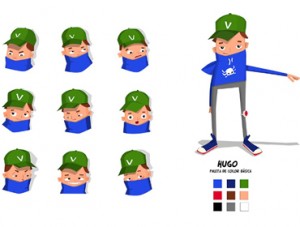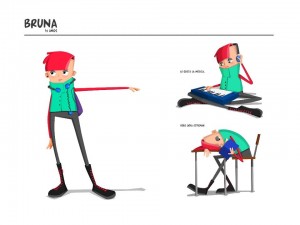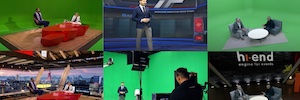Everis y UPF se sirven de la animación para fomentar los estudios científicos-tecnológicos
Industria, Universidad y Administración Pública colaboran en una serie de animación de 4 capítulos que pretende fomentar que los jóvenes escojan estudios científico-tecnológicos.
 La consultora Everis y la Universitat Pompeu Fabra (UPF) preparan Noa & Max. Atrapados en Electronia, una serie de animación que pretende fomentar el talento innovador y el aprendizaje para la creatividad TIC entre los jóvenes. La serie, que cuenta con la financiación de la Fundación Española para la Ciencia y la Tecnología (FECYT), fundación pública dependiente del Ministerio de Economía y Competitividad, va dirigida a los jóvenes de 10 a 14 años y contará con cuatro capítulos piloto de tres minutos de duración que se podrán ver por Internet.
La consultora Everis y la Universitat Pompeu Fabra (UPF) preparan Noa & Max. Atrapados en Electronia, una serie de animación que pretende fomentar el talento innovador y el aprendizaje para la creatividad TIC entre los jóvenes. La serie, que cuenta con la financiación de la Fundación Española para la Ciencia y la Tecnología (FECYT), fundación pública dependiente del Ministerio de Economía y Competitividad, va dirigida a los jóvenes de 10 a 14 años y contará con cuatro capítulos piloto de tres minutos de duración que se podrán ver por Internet.
La serie nace del interés de Everis y la Universitat Pompeu Fabra por el fomento de las vocaciones científico-tecnológicas y el talento innovador entre los estudiantes. Por parte de Everis, como uno de los focos de actuación principal en el ámbito de su Responsabilidad Social Corporativa. Por parte de UPF, dentro de su estrategia de atracción y retención del talento a todos los niveles, tanto en educación como en investigación. Desde 2008, Everis está desarrollando numerosos estudios y proyectos relacionados con la temática de este proyecto, centrándose en la reflexión sobre la problemática de falta de vocaciones en el ámbito científico-técnico y realizando estudios como el Estudio anual sobre la falta ingenieros TIC (2012) o el Factores influyentes en la elección de estudios científicos, tecnológicos y matemáticos (2012).
Por su parte, UPF desarrolla estrategias de captación, atención y formación de los estudiantes en sus ámbitos de actuación y, específicamente, de manera integral para la industria de los media y cultural, desde los contenidos hasta la tecnología que los soportan.
El proyecto
Noa y Max, los dos hermanos protagonistas, tendrán que emplear conocimientos de ciencia y tecnología para salir del videojuego Electronia en el que han quedado atrapados. En las tramas de ficción, que plantearán pequeños retos científico-tecnológicos, se pretenderá mejorar la percepción de los jóvenes de su propia capacidad para entender y poder estudiar fenómenos científicos y tecnológicos, así como potenciar su creatividad y talento innovador.
Sergio Marco, director de Everis, asegura que “queremos hacer de este proyecto un punto de encuentro para profesionales de distintos ámbitos (educadores, animadores, comunicadores…), generando nuevas oportunidades de aprendizaje, de acercamiento a las nuevas tecnologías y a las materias científicas y tecnológicas, y extenderlo a nuevas aplicaciones para los más jóvenes que ayuden a incrementar su interés por las mismas”.
Marco Romeo, investigador GTI – UPF y director de Master en Animación IDEC-UPF destaca que “el proyecto es, además, una oportunidad para introducir a jóvenes animadores en el mundo audiovisual implicándoles en el diseño digital de una producción propia con proyección de futuro”.
El diseño y creación de la serie vienen respaldados por las conclusiones del estudio realizado por la consultora sobre los factores de influencia en la decisión de los estudios en secundaria, realizado a casi 5000 estudiantes de ESO y bachillerato. De esta manera, la serie va dirigida a jóvenes entre 10 y 14 años, ya que según el estudio, a esta edad aún estamos a tiempo de actuar puesto que la decisión no está tomada.
El estudio también indica que las chicas se sienten menos atraídas por la tecnología, de ahí que “queremos cambiar el estereotipo masculino de la tecnología, y ofrecer modelos de referencia a las chicas para incrementar su interés por las TIC”, argumenta Sergio Marco sobre la elección de un protagonista femenino para la serie.
La apuesta por la distribución online se debe a otra de las conclusiones del estudio que señala las plataformas web (56%) y la televisión (29%) como los canales con mayor influencia en la decisión de los jóvenes de estas edades. De ahí también que la serie esté pensada para emitirse por televisión en el futuro.
En las tramas de ficción, que plantearán pequeños retos científico-tecnológicos, se pretenderá mejorar la percepción de los jóvenes de su propia capacidad para entender y poder estudiar fenómenos científicos y tecnológicos, así como su talento innovador. Y es que entre un 45% y un 51% del alumnado no se ve capaz de cursar este tipo de estudios y más de la mitad de los alumnos valoran las materias de química, física y tecnología negativamente frente sólo a una cuarta parte que lo hace en positivo.
Noa & Max contará con dos portales. Por un lado, el institucional, dirigido al público adulto (docentes, padres, profesionales del mundo de la animación y empresas e instituciones) y que ofrecerá la información del proyecto educativo que está tras Noa&Max. Y, por otro lado, el portal juvenil, que estará dirigido al público más joven de la serie donde, además de los capítulos, encontrarán material extra descargable y contenidos adicionales.
La serie cuenta, además, con la financiación del Programa de Cultura Científica y de la Innovación de la FECYT y del Ministerio de Economía y Competitividad, y con la colaboración de entidades del ámbito científico y educativo así como de la innovación tecnológica.
“Hemos conseguido que Industria, Universidad y Administración Pública colaboren en este proyecto para ayudar a solucionar un problema que, en último término, afecta a la empleabilidad de los jóvenes (más del 50% en estos momentos)”, destaca Sergio Marco.
[youtube]http://youtu.be/60vsM82YPn0[/youtube]
Did you like this article?
Subscribe to us RSS feed And you will not miss anything.
















